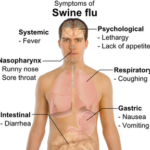With the H1N1 pandemic upon us, people are frantically analyzing every little symptom, trying to determine whether or not they have the swine flu. Symptoms of the pandemic flu are similar to those of regular flu, with a few notable differences.
People suffering from the regular, seasonal flu usually experience the following symptoms: sore throat, dry cough, runny nose, stuffy nose, body aches, chills, headache, and extreme fatigue. Many, though not all, will experience a fever of at least 100 degrees. These symptoms are similar to those of the common cold, but are more intense.
Symptoms of Swine Flu
Symptoms caused by the H1N1 virus are very similar to seasonal flu, except many people also complain of diarrhea and vomiting. While many cases are mild, many people complain of symptoms being more intense than in traditional influenza.
High-Risk Groups for Seasonal Flu
Certain groups are at a higher risk for developing complication from seasonal influenza. These groups include pregnant women, diabetics, asthmatics, those with heart disease, those with kidney disease, children under the age of 2 years, and adults over the age of 65. Complications may be bacterial pneumonia, ear infections, sinus infections, dehydration, and worsening of chronic medical conditions. Some complications lead to hospitalization and death.
High-Risk Groups for H1N1 Influenza
Groups at a higher risk for complications from swine flu are similar to those with seasonal flu. Again included are asthmatics, diabetics, pregnant women, those with heart disease, and those with kidney disease. Also included are those with suppressed immune systems, neurocognitive diseases (e.g. Alzheimer’s disease, HIV complications) and neuromuscular diseases (e.g. muscular dystrophy, multiple sclerosis). Thus far, illness has been worse in people under the age of 25. People over the age of 64, usually at greater risk, are sometimes showing antibodies already present in their system.
Symptoms Requiring Emergency Care in Children
Certain signs indicate the immediate need for emergency care in children. Seek emergency medical attention if the infant or child develops fast breathing or has difficulty breathing. Bluish skin or lips also indicate respiratory distress. If the child is unresponsive or does not wake easily, or if an irritable child refuses to be held for comforting, get help. Signs of dehydration include an inability to urinate or crying without tears. Some may avoid drinking fluids or are unable to keep down fluids. Seizures also require immediate attention. Finally, if symptoms improve, but then return with a fever, a fever with a rash, or a worse cough, consult a medical professional.
Symptoms Requiring Emergency Care in Adults
Adults should seek emergency medical care any time they develop shortness or breath, difficulty breathing, blue or purple lips, or feel pain and/or pressure in the chest and/or abdomen. Sudden dizziness and confusion are also indicators of a worsening condition. Signs of dehydration are an inability to urinate or crying without tears. Severe or persistent vomiting and seizures also require immediate attention.
Prevention
The H1N1 virus is causing more problems because it is new to the human species. The genetic makeup of this virus is similar to that strain of influenza usually found in pigs, as well as containing components of the bird flu virus, and traditional human influenza. If people are diligent about health and hygiene, and avoid contact with the virus, they will be less likely to contract it.
For further information:
Visit the Centers for Disease Control and Flu.gov websites for up-to-date information regarding both the swine flu and seasonal flu outbreaks.
**Information in this article is not designed to replace the advice of a medical professional.**
Resources:
Centers for Disease Control and Prevention Flu Information. http://www.cdc.gov/flu/
Flu.gov: Know What To Do About the Flu http://flu.gov/





